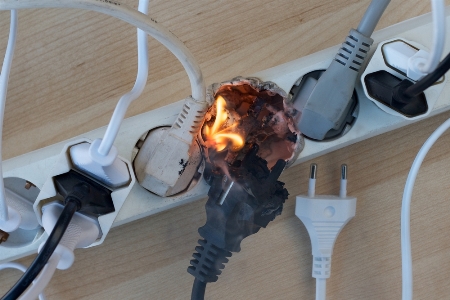Every year, thousands of people in the U.S. are critically injured and electrocuted in their own homes as a result of electrical fires and electrical hazards. The Electrical Safety Foundation International (ESFI) provides a few sobering statistics:
- Home electrical fires cause an estimated 51,000 fires every year, nearly 500 deaths, more than 1,400 injuries, and $1.3 billion in property damage.
- Every year, arcing faults are responsible for more than 28,000 home fires, killing and injuring hundreds of people and causing over $700 million in property damage.
- The U.S. Consumer Product Safety Commission (CPSC) reports that electrical receptacles are involved in 5,300 fires every year, causing 40 deaths and more than 100 injuries.
To help raise awareness about electrical hazards, May is officially National Electrical Safety Month. It’s a good time review the most common hazards and the steps you can take to reduce the risk of electrically-related fires, fatalities, injuries, and property loss.
The DIY problem
Budgets are tight for families across the country and homeowners are seeing declining home values and aging properties, so more people are tackling do-it-yourself projects – and that includes electrical work – instead of hiring licensed professionals. Since most don’t have the training or experience to safely perform electrical work, they’re only increasing the risks.
This old house
Do you live in an older home? According to the U.S. Census Bureau, the average home in the U.S. is more than 37 years old. Today’s higher demand for energy from the use of modern appliances and electrical devices can put a strain on older electrical systems, increasing the risk of fires and electrocutions.
Here are five crucial areas for homeowners and renters to check for electrical hazards:
- Light bulbs. Don’t exceed the light fixture’s recommended maximum wattage, always unplug or turn off lights before changing bulbs, and make sure bulbs are tight because loose bulbs can cause sparks.
- Appliances. Plug only one major appliance into an outlet, and unplug them when not in use. Keep cords away from sinks and bathtubs, and keep pets and children away from cords.
- Cords. Never use frayed, cracked, kinked, or otherwise damaged cords. Never staple or nail cords in place. Extension cords should be used for temporary use only, and never cover up cords with a rug.
- Outlets. Don’t overload outlets, and install tamper-resistant covers. Use ground fault circuit interrupters (GFCI) near water such as kitchens, baths, and basements.
- Outdoors. Assume all power lines are dangerous, especially downed lines. Prune trees to keep them clear of power lines, and keep ladders away from power lines.
Be proactive about electrical safety
Unlike natural disasters, electrical hazards are something you can prevent. If you’ve never done it, you should consider having your home electrical system thoroughly inspected by qualified electricians to make sure all electrical work is safe and working properly. And be aware of the telltale signs of electrical problems such as dim and flickering lights, unusual sizzling or buzzing sounds, or circuit breakers that trip repeatedly. If any of these symptoms are present, contact a qualified electrician.
Visit the National Electrical Safety Month website for more information on this year’s campaign, and find out how you can get involved. For more advice on protecting your home and property, talk to your independent agent.

